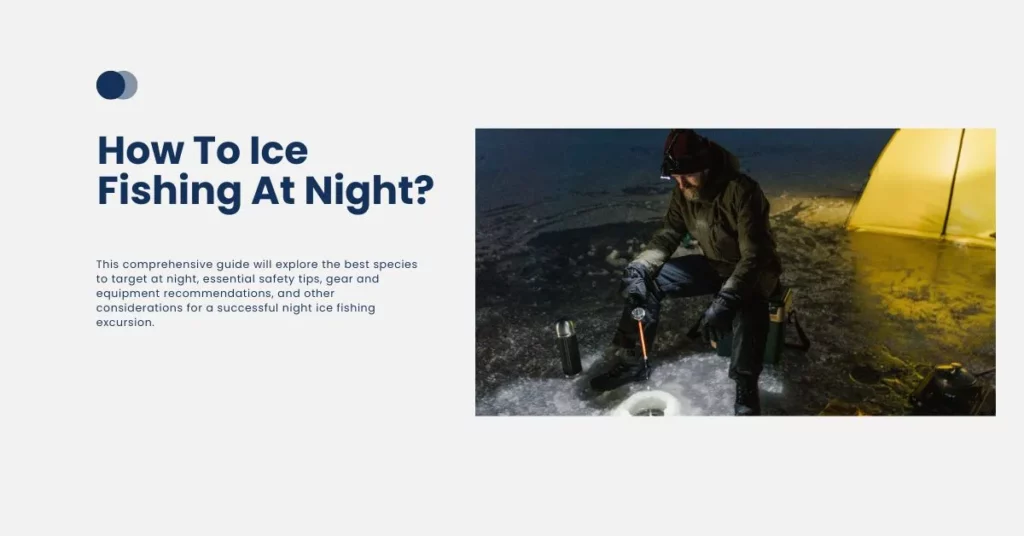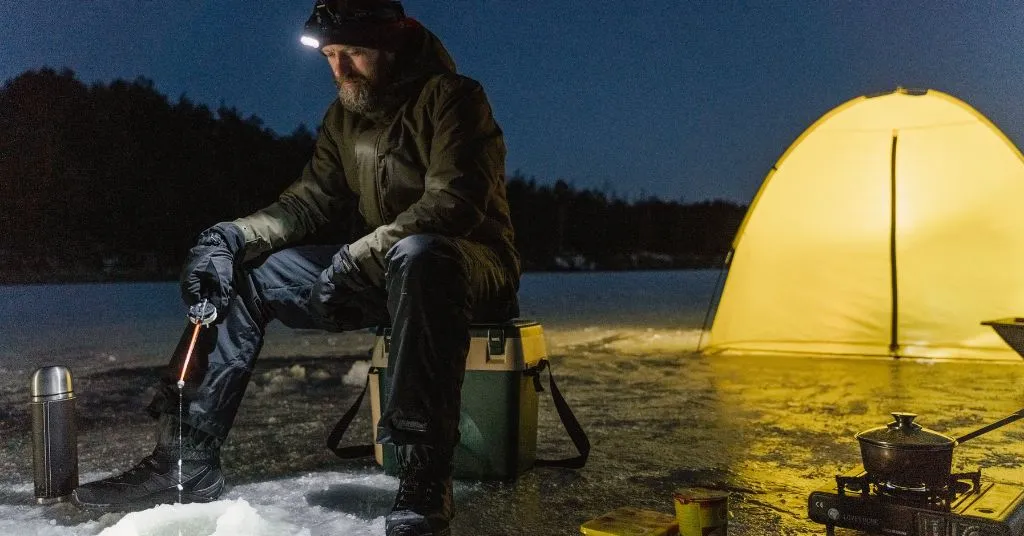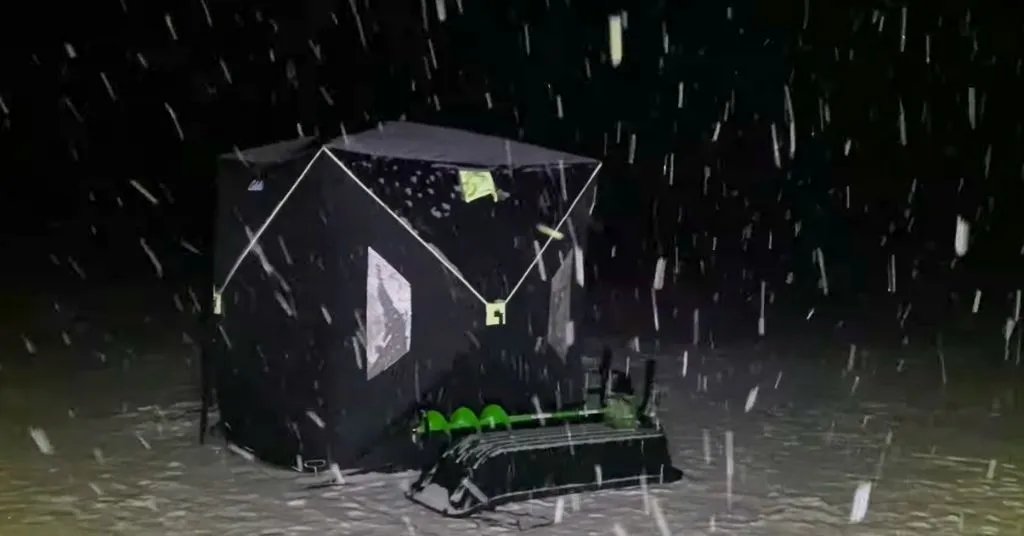
How to Ice Fish At Night? Ice fishing at night introduces a unique and thrilling dimension to this popular winter activity.
The silence of the frozen landscape, coupled with the anticipation of a catch, creates an unforgettable experience for those who seek adventure on frozen waters.
This comprehensive guide will explore the best species to target at night, essential safety tips, gear and equipment recommendations, and other considerations for a successful night ice fishing excursion.
Best Species to Target at Night

Not all fish species are equally active at night, and some are better suited for nocturnal pursuits. Walleye, crappie, and burbot are prime examples of species that exhibit heightened activity during the night.
Their light-sensitive eyes, lateral line organs, and distinct feeding habits make them ideal targets for nighttime ice fishing.
Walleye
Walleyes, known for their elusive behavior, become more active at night. They prefer clear water and often migrate to shallow areas during the dark hours.
To increase your chances of success, focus on fishing during the first and last hour of darkness near weed beds, drop-offs, and points, typically in water between 5 and 15 feet deep. Using silver spoons and lures, drilling multiple holes, and setting up tip-ups or deadsticks are effective techniques for catching walleye at night.
Crappie
Crappies, with their schooling tendency and attraction to light, are another species that are more active at night. Target them during the middle of the night near submerged structures, brush piles, and docks, typically in water between 10 and 20 feet deep.
Utilizing brightly colored lures, jigging slowly and steadily, and employing a fish finder or flasher can significantly improve your chances of a successful crappie catch.
Burbot
Burbot, known for its nocturnal nature, bottom-dwelling habits, and spawning season during late winter and early spring, is a unique target for night ice fishing. Focus on rocky or sandy areas in water between 20 and 40 feet deep.
Employ live or dead bait, jig aggressively and erratically, and use glow-in-the-dark lures or lighted bobbers to attract burbot successfully.
Safety Tips for Ice Fishing at Night

While night ice fishing offers an exciting experience, it comes with challenges and risks. Ensuring safety is paramount for an enjoyable outing. Here are essential safety tips to keep in mind:
Check the Ice Thickness and Quality
Before venturing onto the ice, carefully measure its thickness and quality using an ice auger, ice chisel, or cordless drill. Aim for at least 4 inches of clear, solid ice for walking and at least 12 inches for driving. Be vigilant for signs of weak or thin ice, such as cracks, slush, water, snow, and pressure from other anglers.
Wear a Headlamp and a Flashlight
Visibility is crucial at night. Equip yourself with a reliable headlamp and flashlight to illuminate the ice, holes, gear, and surroundings. Look for features such as high-lumen brightness, a wide field of view, a red-light option, and a waterproof design.
Use a Shanty or a Pop-up
Protect yourself from the elements by using a hut or a pop-up shelter. These structures can block the wind, retain heat, and serve as a marker for your location. Consider factors like size, weight, portability, setup, and cost when choosing between shanties and pop-ups. Enhance visibility by adding reflector tape, LED lights, or flags.
Dress Warmly and in Layers
To prevent hypothermia and frostbite, dress warmly and in layers. Choose clothing made from materials like wool, fleece, and synthetic fabrics. Ensure you have waterproof gloves, hats, boots, and socks.
Have a Buddy or a Communication Device
Never icefish alone at night. Having a buddy or a communication device increases safety and the chances of rescue in case of an emergency. Consider the compatibility, availability, reliability, and cost of having a buddy or a communication device, such as a cell phone, radio, or GPS.
Gear and Equipment for Ice Fishing at Night
Night ice fishing requires specific gear and equipment to enhance your chances of success. In addition to the regular essentials for ice fishing, consider the following:
Rods
Choose rods with the right characteristics for night ice fishing, such as length, action, power, and sensitivity. Opt for light to medium action, 24 to 36 inches long, and a fast or extra fast tip, depending on the species and technique.
Reels
Select reels based on type, size, drag, and line capacity. Spinning or inline reels in the 500 to 1000 series with a smooth, adjustable drag are ideal for night ice fishing.
Lines
Consider the material, diameter, strength, and visibility of lines for night ice fishing. Monofilament, fluorocarbon, or braided lines in 2 to 10 pounds test with low or high visibility, depending on the species and technique.
Lures
Pay attention to the shape, size, color, and action of lures for night ice fishing. Spoons, jigs, swimbaits, or crankbaits in 1/16 to 1/2 ounce with silver, glow, or bright colors are effective choices.
Baits
Select baits based on type, size, color, and scent. Match the bait to the target species and use variations to entice bites. Experiment with live or artificial bait, depending on the preference of the species you are targeting.
Additional Considerations for Night Ice Fishing
Understanding Fish Behavior
While specific species may be more active at night, understanding general fish behavior is crucial. Fish are often more cautious and slow-moving during the night, so adjusting your techniques accordingly is essential.
Hole Placement and Spacing
Strategically placing your fishing holes and maintaining proper spacing is critical for maximizing your chances of success. Spreading out your equipment can help cover a larger area and increase your overall catch.
Patience and Persistence
Night ice fishing requires patience and persistence. Fish may not be as abundant as during the day, but the rewards can be significant. Stay focused, monitor your equipment, and be prepared to wait for the perfect moment.
Conclusion
Ice fishing at night adds an extra layer of excitement to an already thrilling winter activity. Targeting specific species, prioritizing safety, using the right gear, and considering additional factors like fish behavior and hole placement are essential for a successful night on the ice.
By following the tips outlined in this guide, you can enhance your night ice fishing experience and create lasting memories in the quiet,
frozen beauty of the winter night. So, gear up, embrace the darkness, and enjoy the unique adventure of ice fishing at night.
Frequently Asked Questions
Is night ice fishing safe?
Night ice fishing can be safe if proper precautions are taken. Ensure the ice thickness is sufficient, wear appropriate clothing, use visibility aids like headlamps, and never venture onto the ice alone. Following safety guidelines and being aware of your surroundings are crucial for a safe experience.
What species are commonly targeted during night ice fishing?
Walleye, crappie, and burbot are popular species targeted during night ice fishing due to their increased activity in low-light conditions. These species exhibit behaviors that make them more responsive to fishing techniques at night.
What gear is essential for night ice fishing?
Essential gear for night ice fishing includes appropriately sized rods and reels, lines with low visibility, lures or baits tailored to the target species, a shelter (shanty or pop-up), a headlamp and flashlight, and safety equipment such as ice picks and a communication device.
Are there specific regulations for night ice fishing?
Regulations for ice fishing, including those for nighttime, vary by location. It’s essential to check local fishing regulations and obtain the necessary permits. Some areas may have specific rules regarding the use of lights and shelters during night ice fishing.
How do I attract fish at night?
Attracting fish at night involves using lures or baits with reflective or glow features, as they are more visible in the darkness. Additionally, employing techniques like jigging or using underwater lights to draw in baitfish can attract larger predatory fish.
